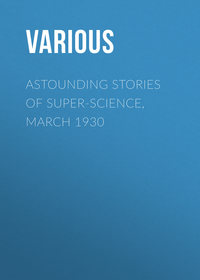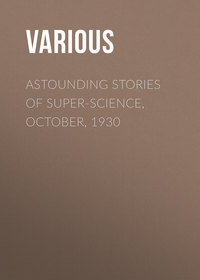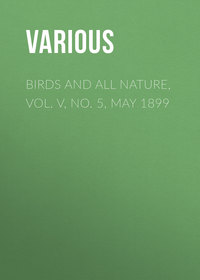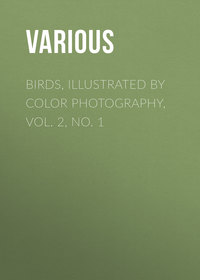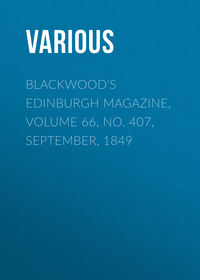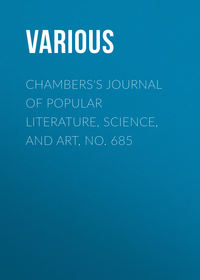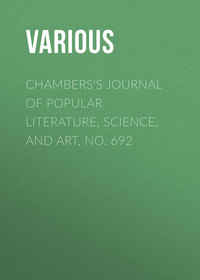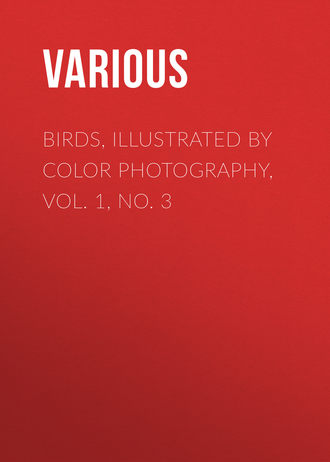 полная версия
полная версияПолная версия
Birds, Illustrated by Color Photography, Vol. 1, No. 3
THE CROW
Caw! Caw! Caw! little boys and girls. Caw! Caw! Caw! Just look at my coat of feathers. See how black and glossy it is. Do you wonder I am proud of it?
Perhaps you think I look very solemn and wise, and not at all as if I cared to play games. I do, though; and one of the games I like best is hide-and-seek. I play it with the farmer in the spring. He hides, in the rich, brown earth, golden kernels of corn. Surely he does it because he knows I like it, for sometimes he puts up a stick all dressed like a man to show where the corn is hidden. Sometimes I push my bill down into the earth to find the corn, and at other times I wait until tiny green leaves begin to show above the ground, and then I get my breakfast without much trouble. I wonder if the farmer enjoys this game as much as I do. I help him, too, by eating worms and insects.
During the spring and summer I live in my nest on the top of a very high tree. It is built of sticks and grasses and straw and string and anything else I can pick up. But in the fall, I and all my relations and friends live together in great roosts or rookeries. What good times we do have – hunting all day for food and talking all night. Wouldn’t you like to be with us?
The farmer who lives in the house over there went to the mill to-day with a load of corn.
One of the ears dropped out of the wagon and it didn’t take me long to find it. I have eaten all I can possibly hold and am wondering now what is the best thing to do. If you were in my place would you leave it here and not tell anybody and come back to-morrow and finish it? Or would you fly off and get Mrs. Crow and some of the children to come and finish it? I believe I’ll fly and get them. Good-bye.
Caw! Caw! Caw!
THE COMMON CROW
“The crow doth sing as merry as the lark,When neither is attended.”FEW birds have more interesting characteristics than the Common Crow, being, in many of his actions, very like the Raven, especially in his love for carrion. Like the Raven, he has been known to attack game, although his inferior size forces him to call to his assistance the aid of his fellows to cope with larger creatures. Rabbits and hares are frequently the prey of this bird which pounces on them as they steal abroad to feed. His food consists of reptiles, frogs, and lizards; he is a plunderer of other birds’ nests. On the seashore he finds crabs, shrimps and inhabited shells, which he ingeniously cracks by flying with them to a great height and letting them fall upon a convenient rock.
The crow is seen in single pairs or in little bands of four or five. In the autumn evenings, however, they assemble in considerable flocks before going to roost and make a wonderful chattering, as if comparing notes of the events of the day.
The nest of the Crow is placed in some tree remote from habitations of other birds. Although large and very conspicuous at a distance, it is fixed upon one of the topmost branches quite out of reach of the hand of the adventurous urchin who longs to secure its contents. It is loosely made and saucer shaped. Sticks and softer substances are used to construct it, and it is lined with hair and fibrous roots. Very recently a thrifty and intelligent Crow built for itself a summer residence in an airy tree near Bombay, the material used being gold, silver, and steel spectacle frames, which the bird had stolen from an optician of that city. Eighty-four frames had been used for this purpose, and they were so ingeniously woven together that the nest was quite a work of art. The eggs are variable, or rather individual, in their markings, and even in their size. The Crow rarely uses the same nest twice, although he frequently repairs to the same locality from year to year. He is remarkable for his attachment to his mate and young, surpassing the Fawn and Turtle Dove in conjugal courtesy.
The Somali Arabs bear a deadly hatred toward the Crow. The origin of their detestation is the superstition that during the flight of Mohammed from his enemies, he hid himself in a cave, where he was perceived by the Crow, at that time a bird of light plumage, who, when he saw the pursuers approaching the spot, perched above Mohammed’s hiding place, and screamed, “Ghar! Ghar!” (cave! cave!) so as to indicate the place of concealment. His enemies, however, did not understand the bird, and passed on, and Mohammed, when he came out of the cave, clothed the Crow in perpetual black, and commanded him to cry “Ghar” as long as Crows should live.
And he lives to a good old age. Instances are not rare where he has attained to half a century, without great loss of activity or failure of sight.
At Red Bank, a few miles northeast of Cincinnati, on the Little Miami River, in the bottoms, large flocks of Crows congregate the year around. A few miles away, high upon Walnut Hills, is a Crow roost, and in the late afternoons the Crows, singly, in pairs, and in flocks, are seen on the wing, flying heavily, with full crops, on the way to the roost, from which they descend in the early morning, crying “Caw! Caw!” to the fields of the newly planted, growing, or matured corn, or corn stacks, as the season may provide.
THE RETURN OF THE BIRDS
“Everywhere the blue sky belongs to them and is their appointed rest, and their native country, and their own natural home which they enter unannounced as lords that are certainly expected, and yet there is a silent joy at their arrival.”
THE return of the birds to their real home in the North, where they build their nests and rear their young, is regarded by all genuine lovers of earth’s messengers of gladness and gayety as one of the most interesting and poetical of annual occurrences. The naturalist, who notes the very day of each arrival, in order that he may verify former observation or add to his material gathered for a new work, does not necessarily anticipate with greater pleasure this event than do many whose lives are brightened by the coming of the friends of their youth, who alone of early companions do not change. First of all – and ever the same delightful warbler – the Bluebird, who, in 1895, did not appear at all in many localities, though here in considerable numbers last year, betrays himself. “Did he come down out of the heaven on that bright March morning when he told us so softly and plaintively that, if we pleased, spring had come?” Sometimes he is here a little earlier, and must keep his courage up until the cold snap is over and the snow is gone. Not long after the Bluebird, comes the Robin, sometimes in March, but in most of the northern states April is the month of his arrival. With his first utterance the spell of winter is broken, and the remembrance of it afar off. Then appears the Woodpecker in great variety, the Flicker usually arriving first. He is always somebody’s old favorite, “announcing his arrival by a long, loud call, repeated from the dry branch of some tree, or a stake in the fence – a thoroughly melodious April sound.”
Few perhaps reflect upon the difficulties encountered by the birds themselves in their returning migrations. A voyager sometimes meets with many of our common birds far out at sea. Such wanderers, it is said, when suddenly overtaken by a fog, completely lose their sense of direction and become hopelessly lost. Humming birds, those delicately organized, glittering gems, are among the most common of the land species seen at sea.
The present season has been quite favorable to the protection of birds. A very competent observer says that not all of the birds migrated this winter. He recently visited a farm less than an hour’s ride from Chicago, where he found the old place, as he relates it, “chucked full of Robins, Blackbirds, and Woodpeckers,” and others unknown to him. From this he inferred they would have been in Florida had indications predicted a severe winter. The trees of the south parks of Chicago, and those in suburban places, have had, darting through their branches during the months of December and January, nearly as many members of the Woodpecker tribe as were found there during the mating season in May last.
Alas, that the Robin will visit us in diminished numbers in the approaching spring. He has not been so common for a year or two as he was formerly, for the reason that the Robins died by thousands of starvation, owing to the freezing of their food supply in Tennessee during the protracted cold weather in the winter of 1895. It is indeed sad that this good Samaritan among birds should be defenseless against the severity of Nature, the common mother of us all. Nevertheless the return of the birds, in myriads or in single pairs, will be welcomed more and more, year by year, as intelligent love and appreciation of them shall possess the popular mind.
THE BLACK TERN
THE TERN,” says Mr. F. M. Woodruff, of the Chicago Academy of Sciences, “is the only representative of the long-winged swimmers which commonly nests with us on our inland fresh water marshes, arriving early in May in its brooding plumage of sooty black. The color changes in the autumn to white, and a number of the adult birds may be found, in the latter part of July, dotted and streaked here and there with white. On the first of June, 1891, I found a large colony of Black Terns nesting on Hyde Lake, Cook County, Illinois. As I approached the marsh a few birds were seen flying high in the air, and, as I neared the nesting site, the flying birds gave notes of alarm, and presently the air was filled with the graceful forms of this beautiful little bird. They circled about me, darting down to within a few feet of my head, constantly uttering a harsh, screaming cry. As the eggs are laid upon the bare ground, which the brownish and blackish markings so closely resemble, I was at first unable to find the nests, and discovered that the only way to locate them was to stand quietly and watch the birds. When the Tern is passing over the nest it checks its flight, and poises for a moment on quivering wings. By keeping my eyes on this spot I found the nest with very little trouble. The complement of eggs, when the bird has not been disturbed, is usually three. These are laid in a saucer shaped structure of dead vegetation, which is scraped together, from the surface of the wet, boggy ground. The bird figured in the plate had placed its nest on the edge of an old muskrat house, and my attention was attracted to it by the fact that upon the edge of the rat house, where it had climbed to rest itself, was the body of a young dabchick, or piedbilled grebe, scarcely two and one-half inches long, and not twenty-four hours out of the egg, a beautiful little ball of blackish down, striped with brown and white. From the latter part of July to the middle of August large flocks of Black Terns may be seen on the shores of our larger lakes on their annual migration southward.”
The Rev. P. B. Peabody, in alluding to his observation of the nests of the Tern, says: “Amid this floating sea of aquatic nests I saw an unusual number of well constructed homes of the Tern. Among these was one that I count a perfect nest. It rested on the perfectly flat foundation of a small decayed rat house, which was about fourteen inches in diameter. The nest, in form, is a truncated cone (barring the cavity), was about eight inches high and ten inches in diameter. The hollow – quite shallow – was about seven inches across, being thus unusually large. The whole was built up of bits of rushes, carried to the spot, these being quite uniform in length – about four inches.” After daily observation of the Tern, during which time he added much to his knowledge of the bird, he pertinently asks: “Who shall say how many traits and habits yet unknown may be discovered through patient watching of community-breeding birds, by men enjoying more of leisure for such delightful studies than often falls to the lot of most of us who have bread and butter to earn and a tiny part of the world’s work to finish?”
THE MEADOW LARK
“Not an inch of his body is free from delight.Can he keep himself still if he would? Oh, not he!The music stirs in him like wind through a tree.”THE well known Meadow or Old Field Lark is a constant resident south of latitude 39, and many winter farther north in favorite localities. Its geographical range is eastern North America, Canada to south Nova Scotia, Quebec, and Ontario to eastern Manitoba; west to Minnesota, Iowa, Missouri, eastern Kansas, the Indian Territory, and Texas; south to Florida and the Gulf coast, in all of which localities, except in the extreme north, it usually rears two or three broods in a season. In the Northern States it is only a summer resident, arriving in April and remaining until the latter part of October and occasionally November. Excepting during the breeding season, small flocks may often be seen roving about in search of good feeding grounds. Major Bendire says this is especially true in the fall of the year. At this time several families unite, and as many as two dozen may occasionally be flushed in a field, over which they scatter, roaming about independently of each other. When one takes wing all the others in the vicinity follow. It is a shy bird in the East, while in the middle states it is quite the reverse. Its flight is rather laborious, at least in starting, and is continued by a series of rapid movements of the wings, alternating with short distances of sailing, and is rarely protracted. On alighting, which is accompanied with a twitching of its tail, it usually settles on some fence rail, post, boulder, weedstock, or on a hillock in a meadow from which it can get a good view of the surroundings, and but rarely on a limb of a tree. Its favorite resorts are meadows, fallow fields, pastures, and clearings, but in some sections, as in northern Florida, for instance, it also frequents the low, open pine woods and nests there.
The song of the Meadow Lark is not much varied, but its clear, whistling notes, so frequently heard in the early spring, are melodious and pleasing to the ear. It is decidedly the farmers’ friend, feeding, as it does, on noxious insects, caterpillars, moths, grasshoppers, spiders, worms and the like, and eating but little grain. The lark spends the greater part of its time on the ground, procuring all its food there. It is seldom found alone, and it is said remains paired for life.
Nesting begins in the early part of May and lasts through June. Both sexes assist in building the nest, which is always placed on the ground, either in a natural depression, or in a little hollow scratched out by the birds, alongside a bunch of grass or weeds. The nest itself is lined with dry grass, stubble, and sometimes pine needles. Most nests are placed in level meadows. The eggs and young are frequently destroyed by vermin, for the meadow lark has many enemies. The eggs vary from three to seven, five being the most common, and both sexes assist in the hatching, which requires about fifteen or sixteen days. The young leave the nest before they are able to fly – hiding at the slightest sign of danger. The Meadow Lark does not migrate beyond the United States. It is a native bird, and is only accidental in England. The eggs are spotted, blotched, and speckled with shades of brown, purple and lavender. A curious incident is told of a Meadow Lark trying to alight on the top mast of a schooner several miles at sea. It was evidently very tired but would not venture near the deck.
THE MEADOW LARK
I told the man who wanted my picture that he could take it if he would show my nest and eggs. Do you blame me for saying so? Don’t you think it makes a better picture than if I stood alone?
Mr. Lark is away getting me some breakfast, or he could be in the picture, too. After a few days I shall have some little baby birds, and then won’t we be happy.
Boys and girls who live in the country know us pretty well. When they drive the cows out to pasture, or when they go out to gather wild flowers, we sit on the fences by the roadside and make them glad with our merry song.
Those of you who live in the city cannot see us unless you come out into the country.
It isn’t very often that we can find such a pretty place for a nest as we have here. Most of the time we build our nest under the grass and cover it over, and build a little tunnel leading to it. This year we made up our minds not to be afraid.
The people living in the houses over there do not bother us at all and we are so happy.
You never saw baby larks, did you? Well, they are queer little fellows, with hardly any feathers on them.
Last summer we had five little birdies to feed, and it kept us busy from morning till night. This year we only expect three, and Mr. Lark says he will do all the work. He knows a field that is being plowed, where he can get nice, large worms.
Hark! that is he singing. He will be surprised when he comes back and finds me off the nest. He is so afraid that I will let the eggs get cold, but I won’t. There he comes, now.
THE LONG-EARED OWL
THE name of the Long-Eared Owl is derived from the great length of his “ears” or feather-tufts, which are placed upon the head, and erect themselves whenever the bird is interested or excited. It is the “black sheep” of the owl family, the majority of owls being genuine friends of the agriculturist, catching for his larder so many of the small animals that prey upon his crops. In America he is called the Great Horned Owl – in Europe the Golden Owl.
Nesting time with the owl begins in February, and continues through March and April. The clown-like antics of both sexes of this bird while under the tender influence of the nesting season tend somewhat to impair their reputation for dignity and wise demeanor. They usually have a simple nest in a hollow tree, but which seems seldom to be built by the bird itself, as it prefers to take the deserted nest of some other bird, and to fit up the premises for its own use. They repair slightly from year to year the same nest. The eggs are white, and generally four or five in number. While the young are still in the nest, the parent birds display a singular diligence in collecting food for them.
If you should happen to know of an owl’s nest, stand near it some evening when the old birds are rearing their young. Keep quiet and motionless, and notice how frequently the old birds feed them. Every ten minutes or so the soft flap, flap of their wings will be heard, the male and female alternately, and you will obtain a brief glimpse of them through the gloom as they enter the nesting place. They remain inside but a short time, sharing the food equally amongst their brood, and then are off again to hunt for more. All night, were you to have the inclination to observe them, you would find they pass to and fro with food, only ceasing their labors at dawn. The young, as soon as they reach maturity, are abandoned by their parents; they quit the nest and seek out haunts elsewhere, while the old birds rear another, and not infrequently two more broods, during the remainder of the season.
The habits of the Long-Eared Owl are nocturnal. He is seldom seen in the light of day, and is greatly disturbed if he chance to issue from his concealment while the sun is above the horizon. The facial disk is very conspicuous in this species. It is said that the use of this circle is to collect the rays of light, and throw them upon the eye. The flight of the owl is softened by means of especially shaped, recurved feather-tips, so that he may noiselessly steal upon his prey, and the ear is also so shaped as to gather sounds from below.
The Long-Eared Owl is hardly tameable. The writer of this paragraph, when a boy, was the possessor, for more than a year, of a very fine specimen. We called him Judge. He was a monster, and of perfect plumage. Although he seemed to have some attachment to the children of the family who fed him, he would not permit himself to be handled by them or by any one in the slightest. Most of his time he spent in his cage, an immense affair, in which he was very comfortable. Occasionally he had a day in the barn with the rats and mice.
The owl is of great usefulness to gardener, agriculturist, and landowner alike, for there is not another bird of prey which is so great a destroyer of the enemies of vegetation.
THE OWL
We know not alwayWho are kings by day,But the king of the night is the bold brown owl!I wonder why the folks put my picture last in the book. It can’t be because they don’t like me, for I’m sure I never bother them. I don’t eat the farmer’s corn like the crow, and no one ever saw me quarrel with other birds.
Maybe it is because I can’t sing. Well, there are lots of good people that can’t sing, and so there are lots of good birds that can’t sing.
Did you ever see any other bird sit up as straight as I do? I couldn’t sit up so straight if I hadn’t such long, sharp claws to hold on with.
My home is in the woods. Here we owls build our nests – most always in hollow trees.
During the day I stay in the nest or sit on a limb. I don’t like day time for the light hurts my eyes, but when it begins to grow dark then I like to stir around. All night long I am wide awake and fly about getting food for my little hungry ones. They sleep most of the day and it keeps me busy nearly all night to find them enough to eat.
I just finished my night’s work when the man came to take my picture. It was getting light and I told him to go to a large stump on the edge of the woods and I would sit for my picture. So here I am. Don’t you think I look wise? How do you like my large eyes? If I could smile at you I would, but my face always looks sober. I have a great many cousins and if you really like my picture, I’ll have some of them talk to you next month. I don’t think any of them have such pretty feathers though. Just see if they have when they come.
Well, I must fly back to my perch in the old elm tree. Good-bye.
THE OWL
In the hollow tree, in the old gray tower,The spectral owl doth dwell;Dull, hated, despised in the sunshine hour,But at dusk he’s abroad and well!Not a bird of the forest e’er mates with him;All mock him outright by day;But at night, when the woods grow still and dim,The boldest will shrink away!O! when the night falls, and roosts the fowl,Then, then, is the reign of the Horned Owl!And the owl hath a bride, who is fond and bold,And loveth the wood’s deep gloom;And, with eyes like the shine of the moonstone cold,She awaiteth her ghastly groom.Not a feather she moves, not a carol she sings,As she waits in her tree so still,But when her heart heareth his flapping wings,She hoots out her welcome shrill!O! when the moon shines, and dogs do howl,Then, then, is the joy of the Horned Owl!Mourn not for the owl, nor his gloomy plight!The owl hath his share of good —If a prisoner he be in the broad daylight,He is lord in the dark greenwood!Nor lonely the bird, nor his ghastly mate,They are each unto each a pride;Thrice fonder, perhaps, since a strange, dark fateHath rent them from all beside!So, when the night falls, and dogs do howl,Sing, Ho! for the reign of the Horned Owl!We know not alwayWho are kings by day,But the King of the Night is the bold Brown Owl!Bryan W. Procter(Barry Cornwall.)TESTIMONIALS
Frankfort, Ky., February 3, 1897.W. J. Black, Vice-President,
Chicago, Ill.
Dear Sir: I have a copy of your magazine entitled “Birds,” and beg to say that I consider it one of the finest things on the subject that I have ever seen, and shall be pleased to recommend it to county and city superintendents of the state.
Very respectfully,W. J. Davidson,State Superintendent Public Instruction.San Francisco, Cal., January 27, 1897.W. J. Black, Esq.,
Chicago, Ill.
Dear Sir: I am very much obliged for the copy of “Birds” that has just come to hand. It should be in the hands of every primary and grammar teacher. I send herewith copy of “List of San Francisco Teachers.”
Very respectfully,M. Babcock.Lincoln, Neb., February 9, 1897.W. J. Black,
Chicago, Ill.
Dear Sir: The first number of your magazine, “Birds,” is upon my desk. I am highly pleased with it. It will prove a very serviceable publication – one that strikes out along the right lines. For the purpose intended, it has, in my opinion, no equal. It is clear, concise, and admirably illustrated.
Very respectfully,W. R. Jackson,State Superintendent Public Instruction.North Lima, Ohio, February 1, 1897.Mr. W. E. Watt,




